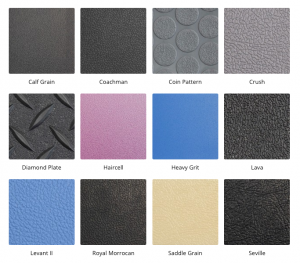 Let’s talk textures. Texture is an area in which thermoformed products have a distinct advantage over many other plastic processes such as injection molding, rotational molding, blow molding, etc. Unlike fiberglass and the aforementioned plastic processes, thermoformed (or vacuum formed) parts which require a texture don’t pick up this texture from the mold surface. The texture is present on the thermoformable sheet when delivered to the company who will be doing the thermoforming. In other processes, when a specific texture is required, the mold surface must be etched or manipulated to reflect the look which you want the hot thermoplastic or thermoset (as in the case with fiberglass) to pick up.
Let’s talk textures. Texture is an area in which thermoformed products have a distinct advantage over many other plastic processes such as injection molding, rotational molding, blow molding, etc. Unlike fiberglass and the aforementioned plastic processes, thermoformed (or vacuum formed) parts which require a texture don’t pick up this texture from the mold surface. The texture is present on the thermoformable sheet when delivered to the company who will be doing the thermoforming. In other processes, when a specific texture is required, the mold surface must be etched or manipulated to reflect the look which you want the hot thermoplastic or thermoset (as in the case with fiberglass) to pick up.
Etching molds or modifying a mold surface is costly and time consuming. Furthermore, once it has been done…there is no going back…at least not easily. The customer is stuck with that texture until they decide they want something different and pay to have the mold modified again…if it is even possible. Modifying molds can affect the surface quality and size of the tool. Parts with tight tolerances may start having issues with fit once a mold surface has been modified again since you are usually taking away material from the mold surface to create the texture. As a general rule, in thermoforming, we generally don’t want “A” (cosmetic) side of the plastic sheet to touch the mold surface…which is the exact opposite from the other plastic processes mentioned above.
With thermoformed parts, the sheet surface determines the mold texture. Thermoplastic sheet suppliers produce sheet which has a texture embossed onto it. If a customer decides they want a different texture, we simply tell our sheet supplier we want the new texture and the sheet is run with the new texture on it. Generally there is no additional cost involved to change textures. Each sheet supplier has different textures available. Some of these include: haircell (very common in thermoformed products), smooth, matte, satin, levant, seville, calf, morrocan, leatherette, safety grip, deep groove, pyramid and many others. The texture of the sheet can affect the gloss level, can affect how much grip the part has or can be used to replicate the look of leather such as when trying to match vehicle interiors.
In addition to a wide variety of textures available, thermoformers also have the ability to add laminates to the top of their sheet. There are just as many laminate options as there are texture options…if not more. And just like a texture, a laminate on top of plastic sheet can totally change the look of a part. I’ll talk about laminates in a later blog post…
If you are interested in looking at different textures and what is available for your thermoformed plastic part, please don’t hesitate to give us a call!

